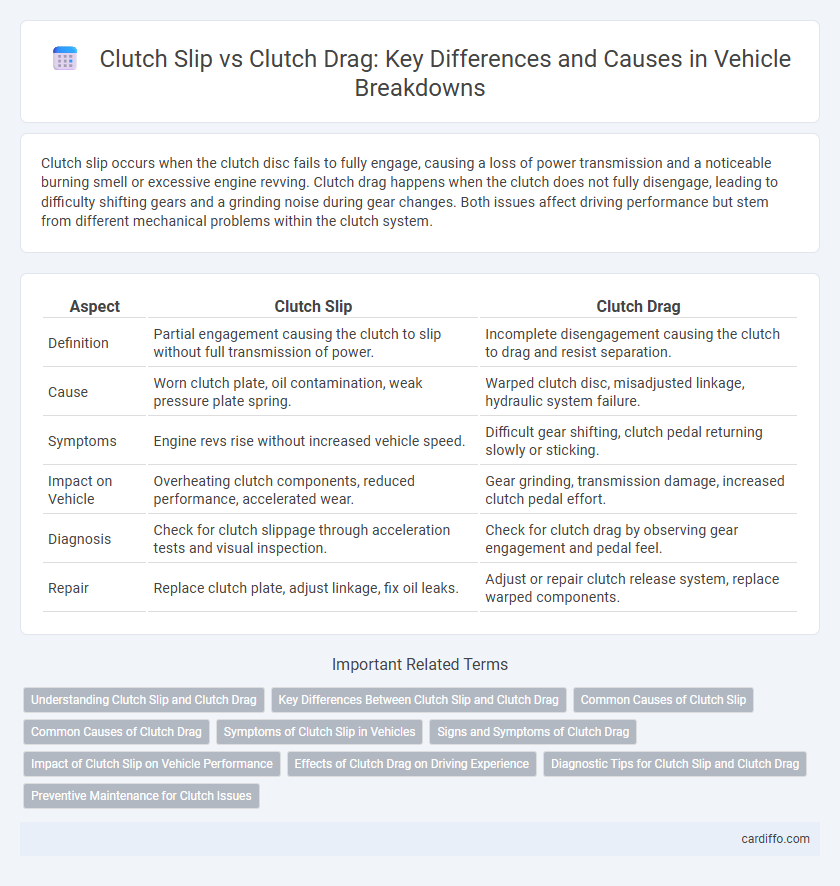Clutch slip occurs when the clutch disc fails to fully engage, causing a loss of power transmission and a noticeable burning smell or excessive engine revving. Clutch drag happens when the clutch does not fully disengage, leading to difficulty shifting gears and a grinding noise during gear changes. Both issues affect driving performance but stem from different mechanical problems within the clutch system.
Table of Comparison
| Aspect | Clutch Slip | Clutch Drag |
|---|---|---|
| Definition | Partial engagement causing the clutch to slip without full transmission of power. | Incomplete disengagement causing the clutch to drag and resist separation. |
| Cause | Worn clutch plate, oil contamination, weak pressure plate spring. | Warped clutch disc, misadjusted linkage, hydraulic system failure. |
| Symptoms | Engine revs rise without increased vehicle speed. | Difficult gear shifting, clutch pedal returning slowly or sticking. |
| Impact on Vehicle | Overheating clutch components, reduced performance, accelerated wear. | Gear grinding, transmission damage, increased clutch pedal effort. |
| Diagnosis | Check for clutch slippage through acceleration tests and visual inspection. | Check for clutch drag by observing gear engagement and pedal feel. |
| Repair | Replace clutch plate, adjust linkage, fix oil leaks. | Adjust or repair clutch release system, replace warped components. |
Understanding Clutch Slip and Clutch Drag
Clutch slip occurs when the clutch disc fails to fully engage with the flywheel, causing loss of power transmission and excessive heat buildup, often resulting in premature wear and reduced vehicle performance. Clutch drag happens when the clutch does not fully disengage, leading to difficulty in gear shifting and potential transmission damage due to continuous contact between the clutch disc and flywheel. Understanding these conditions is crucial for diagnosing clutch system issues and maintaining efficient drivetrain operation.
Key Differences Between Clutch Slip and Clutch Drag
Clutch slip occurs when the clutch disc fails to fully engage, causing a loss of power transmission and resulting in excessive heat and wear. In contrast, clutch drag happens when the clutch disc does not fully disengage, leading to difficulty shifting gears and premature clutch component damage. Key differences include clutch slip manifesting as engine revving without corresponding vehicle acceleration, while clutch drag often causes grinding noises and gear engagement problems.
Common Causes of Clutch Slip
Clutch slip commonly occurs due to worn clutch plates, contaminated friction surfaces from oil or grease, and improper clutch adjustment leading to insufficient pressure. Overheating from prolonged use or aggressive driving also reduces friction material effectiveness, causing the clutch to slip. Mechanical failures such as weakened pressure springs or a damaged release bearing further contribute to clutch slipping issues.
Common Causes of Clutch Drag
Clutch drag commonly occurs due to improper clutch pedal adjustment, warped clutch discs, or contamination of the friction surfaces with oil or grease. Worn or damaged release bearings and pressure plates can also lead to incomplete disengagement, causing clutch drag. Insufficient hydraulic pressure in the clutch system or a faulty slave cylinder frequently contribute to this problem by preventing the clutch from fully releasing.
Symptoms of Clutch Slip in Vehicles
Clutch slip in vehicles is characterized by a noticeable loss of acceleration despite increasing engine RPM, often accompanied by a burning smell and a spongy clutch pedal feel. Drivers may experience difficulty maintaining speed on inclines and observe delayed or sluggish engagement when shifting gears. These symptoms indicate worn clutch plates, insufficient hydraulic pressure, or oil contamination, requiring immediate inspection to prevent further transmission damage.
Signs and Symptoms of Clutch Drag
Clutch drag occurs when the clutch does not fully disengage, causing difficulty in shifting gears and a noticeable grinding noise during gear changes. Signs of clutch drag include a stiff or hard clutch pedal, gears that grind or refuse to engage smoothly, and the vehicle creeping forward even when the clutch pedal is fully pressed. Diagnosing clutch drag early prevents damage to the transmission and ensures optimal clutch performance.
Impact of Clutch Slip on Vehicle Performance
Clutch slip significantly reduces vehicle performance by causing inefficient power transfer from the engine to the wheels, leading to decreased acceleration and increased fuel consumption. This condition accelerates clutch wear and heat buildup, potentially resulting in premature clutch failure and costly repairs. Unlike clutch drag, which hinders smooth gear engagement, clutch slip directly compromises vehicle responsiveness and drivability.
Effects of Clutch Drag on Driving Experience
Clutch drag causes incomplete disengagement of the clutch, leading to gear grinding and difficulty shifting smoothly. It results in increased wear on transmission components and can cause jerky or rough acceleration. Drivers may experience reduced fuel efficiency and increased stress on the drivetrain during operation.
Diagnostic Tips for Clutch Slip and Clutch Drag
Clutch slip is diagnosed by observing engine rev increases without corresponding acceleration, often confirmed by a slipping clutch test involving gradual throttle application in gear. Clutch drag presents as difficulty shifting gears or gear grinding, detected through a clutch pedal free play check and inspecting linkage or hydraulic system for proper disengagement. Accurate diagnosis requires measuring pedal travel, checking for fluid leaks, and testing clutch engagement under load to differentiate between slip and drag issues.
Preventive Maintenance for Clutch Issues
Clutch slip and clutch drag can lead to significant vehicle performance issues if not addressed promptly through preventive maintenance. Regular inspection of the clutch assembly, including checking the clutch fluid, cable adjustments, and wear on the friction plate, is essential to avoid premature failure. Scheduling routine maintenance and timely replacement of worn components enhances clutch responsiveness and extends the lifespan of the transmission system.
Clutch slip vs clutch drag Infographic

 cardiffo.com
cardiffo.com